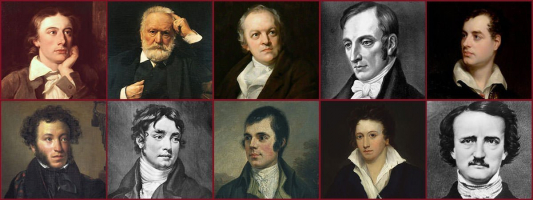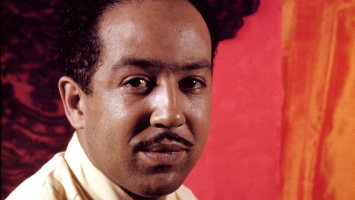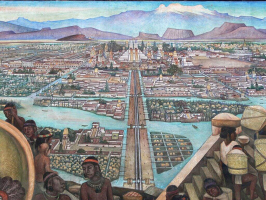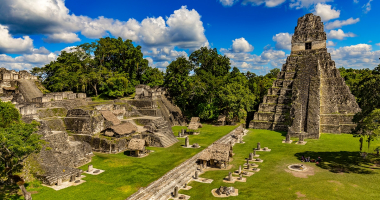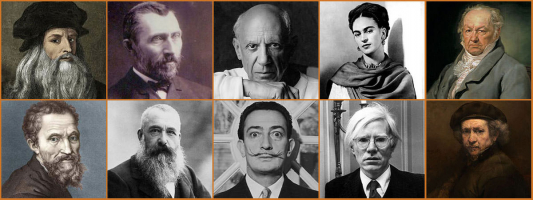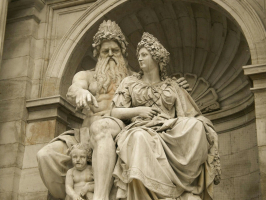Top 8 Most Famous Achievements of the Qin Dynasty
The Qin Dynasty, which ruled China from 221 to 206 BC, was the country's first imperial dynasty. Even though it was only in power for a brief period of time, ... read more...the Qin Dynasty had a significant impact on China's growth. It marked both the conclusion of the Warring States Period (656-221 BC) and the unity of the medieval kingdom. Additionally, there was also the standardization of writing systems, codes, measurement units, and currency. The Qin Dynasty is known for its technical wonders including the Great Wall of China, the Terracotta Army, the Lingqu Canal, and the Dujiangyan Irrigation System. Here are the 8 Most Famous Achievements of the Qin Dynasty that Toplist would like to introduce to readers.
-
Originally, the Qin Dynasty was a region with a history of giving rise to early Chinese culture. It is situated in China's Northwest Plain, where the land is extremely rich and has a high agricultural production. The nation's abundance of iron ore, which is used to quickly make massive amounts of iron weaponry, also contributes to its technological advancement. The Qin Dynasty also had significant military and social advantages. Instead of concentrating on the customary task of building alliances, they concentrated on enslaving their neighbors, assassinating their kings, and then taking direct control of them. The emperor also eliminated centralized bureaucracy and aristocratic families by refusing to make concessions to mandarins, intellectuals, or aristocrats. This indicates that the nation will no longer be ruled by forces that are rebellious and power-hungry.
The Warring States era, which lasted from 475 BC to 221 BC, is the time before the Qin dynasty in Chinese history. Han, Zhao, Yan, Wei, Zhou, Qi, and Qin were among the seven warring nations states that dominated it. In 230 BC, King Zheng of the Qin started his quest to annex the remaining six nations. As a result, the Han Dynasty was captured this year. The Zhao Dynasty, Yan Dynasty, Wei Dynasty, Zhou Dynasty, and Qi Dynasty all also fell in the years 228 BC, 226 BC, 225 BC, and 221 BC, respectively. Thus, in 221 BC, for the first time in history, China established itself as a centralized unified state. It took King Zheng fewer than ten years to unite China. He became the first emperor of a united China and adopted the title "Qin Shi Huang," which means "First Emperor of Qin".
In other words, China did not exist before the Qin Dynasty. At that time, each warring state had its own system of politics, culture, language, and measurement. However, through the use of legalist ideas, the Qin Dynasty subdued the warring states. Additionally, it gave the Emperor the power to punish his people severely in an effort to alter their conduct and advance the interests of the state and the monarchy. Legalism has brought together seven mighty countries into one country with a single language, a single national identity, and a single set of rules. It was the combination of natural and human factors that helped the Qin Dynasty unify China for the first time during its rule.
To conclude, China's unification for the first time in history:
- The combination of natural and human factors helped the Qin Dynasty unify China for the first time.
- The Qin Dynasty has extremely rich natural resources with significant military and social advantages.
- It focused on enslaving their neighbors, assassinating their kings, and then directly controlling them with the use of legalism.
- In 230 BC, the Qin Dynasty began the process of annexing six countries including Han, Zhao, Yan, Wei, Zhou, and Qi.
- By 221 BC, for the first time in Chinese history, China established itself as a centralized unified state with its first Emperor, Qin Shi Huang.
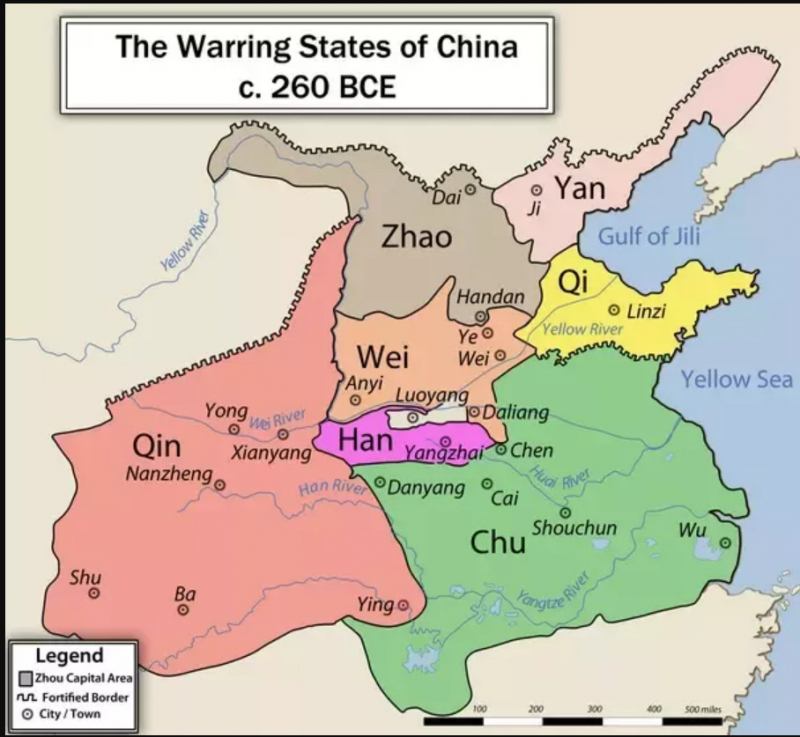
Seven warring nations states - Photo: thoughtco.com 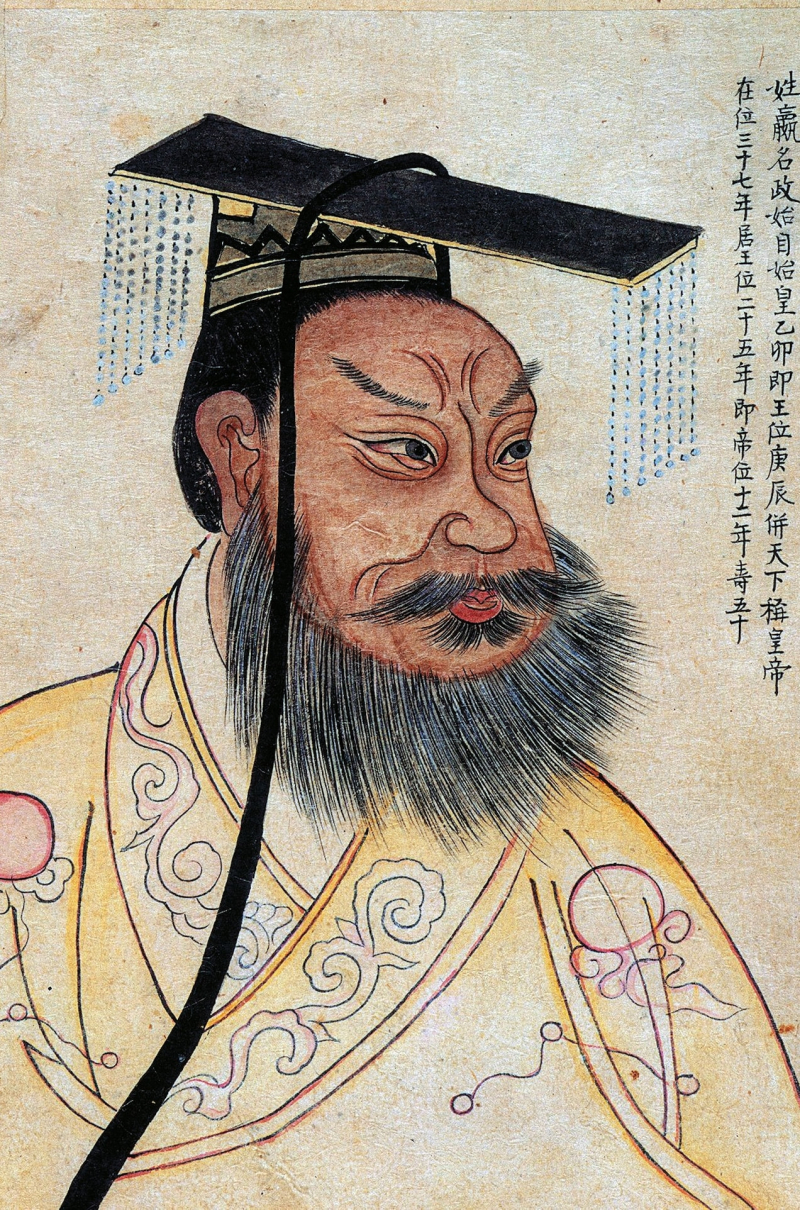
Qin Shi Huang - Photo: wikipedia.org - The combination of natural and human factors helped the Qin Dynasty unify China for the first time.
-
After the Qin state unified China in 221 BC, Qin Shi Huang ended the hereditary vassal system under the Qin Dynasty with the aid of prime minister Li Si. Additionally, the change substitutes a new administrative setup and prevents political upheaval.
First of all, China is split up into administrative units. Qin Shi Huang divided the Qin dynasty into 36 Jun (county), under which were several districts of Xi'an. Each Xi'an is followed by a town called Xiang, and then the Ting, which is further split into Li, the smallest administrative subdivisions for rural areas. The imperial capital was governed by a Chamberlain and was not included in the normal administrative units. Administrative control over a command body is administered by a Governor (Shou), who manages general administration, and a Guard (Wei), who is in charge of managing military garrisons. Judges (Ling) are in charge of running counties. Responsibility for control of the town is divided among 3 people including an Elder (called Sanlao) who has moral authority, a person who manages the town's finances (called Sefu), and a patrolman (called Youjiao) who maintains order in the community.
More importantly, this arrangement divided China into administrative divisions where all officials were appointed through merit rather than on a hereditary basis. It means that hereditary rights and powerful backgrounds gradually became meaningless in the court of the Qin Dynasty. There was no official hiring process in place during the Qin Dynasty. All appointments up to the county level are based on the basis of recommendations and made by the Grand Chancellor and the Emperor for an undetermined period of time. Important positions belonged to military officers who achieved outstanding achievements in battles. Officials may receive titles rated 20 to 1 for merit, but those titles are not hereditary and do not confer titles to those in power.
The fundamental framework of Chinese administration over the following 2,000 years was created by the Qin Dynasty's administrative system. Some were altered by subsequent dynasties, but the principles of the Authority of Merit were kept. The central authority was greatly strengthened by the political cohesiveness that this system brought forth.
In sum:
- After the unification of China in 221 BC, Qin Shi Huang ended the hereditary vassal system under the Qin dynasty and established a new administrative system to prevent political upheaval.
- China is divided into administrative divisions of 36 Jun (county), under which are several counties (Xian), towns (Xiang), counties (Ting), and villages (Li); and under the control of its own command agencies.
- All officials are appointed through merit rather than hereditary and are made by the Grand Chancellor and Emperor.
- The basic framework of Chinese administration for the next 2,000 years was developed by the administrative system of the Qin Dynasty.
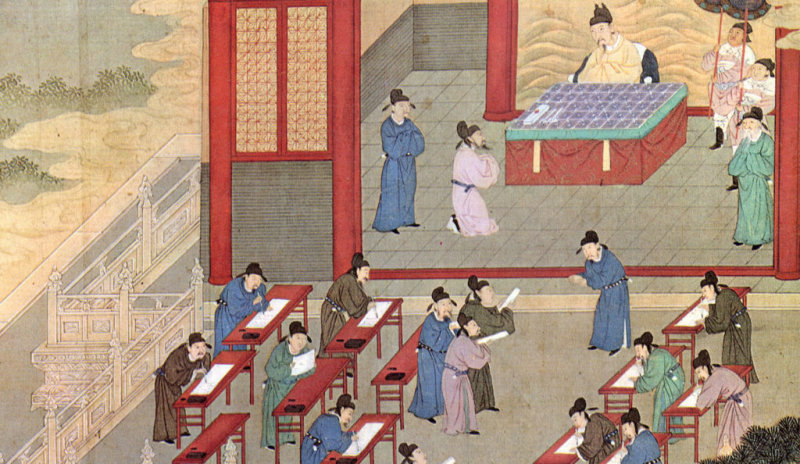
Civil-service exam in the Qin Dynasty - Photo: theknowledge.com 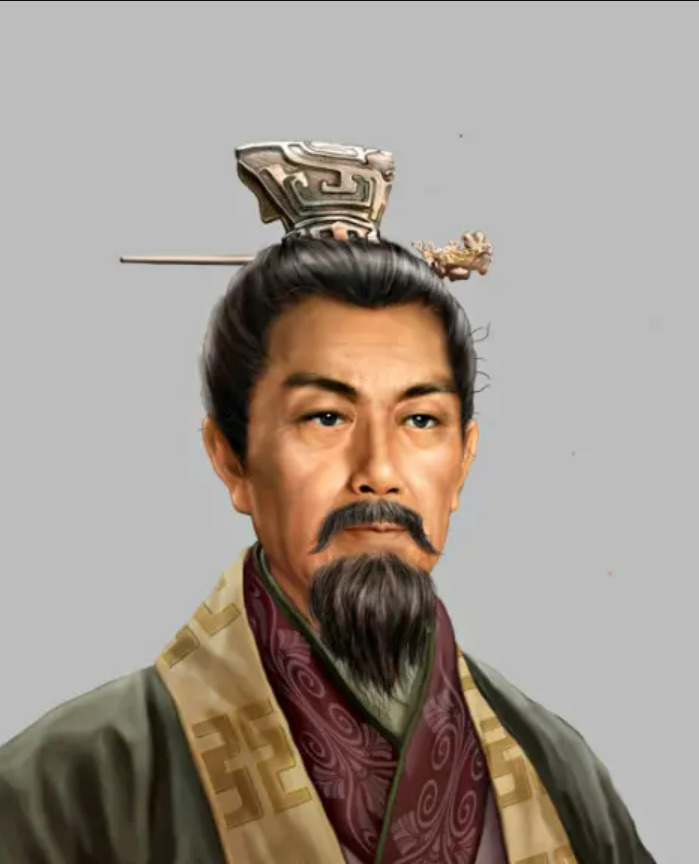
Li Si - Photo: daydaynews.cc -
Before the Qin succeeded in unifying China, local styles of characters developed independently of one another over a long period of time, resulting in what is known as the "Scripts of the Six States". However, the characters in the Large Seal Script varied depending on where they were used. In a single government, this variety was undesirable since it made it difficult to trade, tax, or move about. Therefore, the Qin Emperor desired that one particular writing become legitimate across China. He requested the creation of a certain form for everyone to be aware of in 220 BC from his academics and Prime Minister Li Si.
After that, Li Si standardized the written Chinese language, which was already in use in Qin's realm and served as the imperial standard. The new script, now known as the Small Seal Script, underwent another round of standardization by getting rid of all of its various forms. The First Emperor of China standardized the smaller seal scripts, which developed from the bigger seal scripts of earlier dynasties, once he took control of the nation. A brand-new, codified style known as the Small Seal Script was first used and has since endured very few changes.
The Chinese writing system was unified throughout China as a result of this standardization. In addition, it had a lasting positive impact on Chinese culture over the next thousands of years.
To conclude, the Qin Dynasty standardized the Chinese writing system:
- in 220 BC by Prime Minister Li Si.
- the appearance of the Small Seal Script replaced the Large Seal Script which existed for thousands of years in Chinese and made it difficult to trade, tax, or move about.
- Standardization of the writing system also brought great benefits to the unification of Chinese culture.
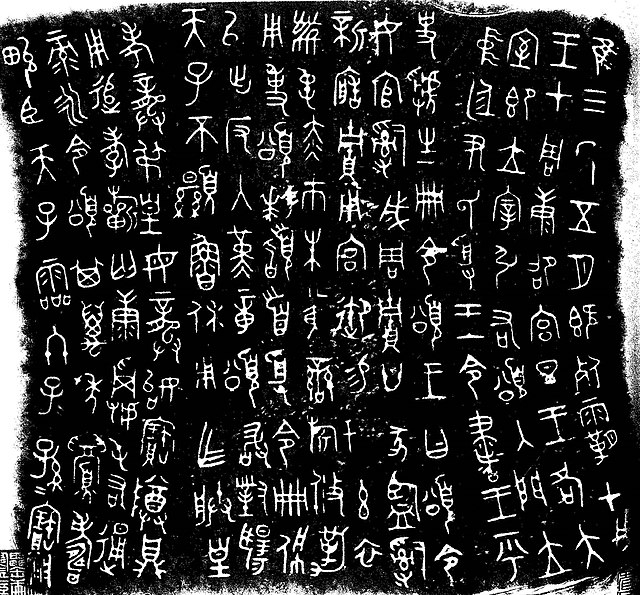
Large seal script - Photo: wikipedia.org 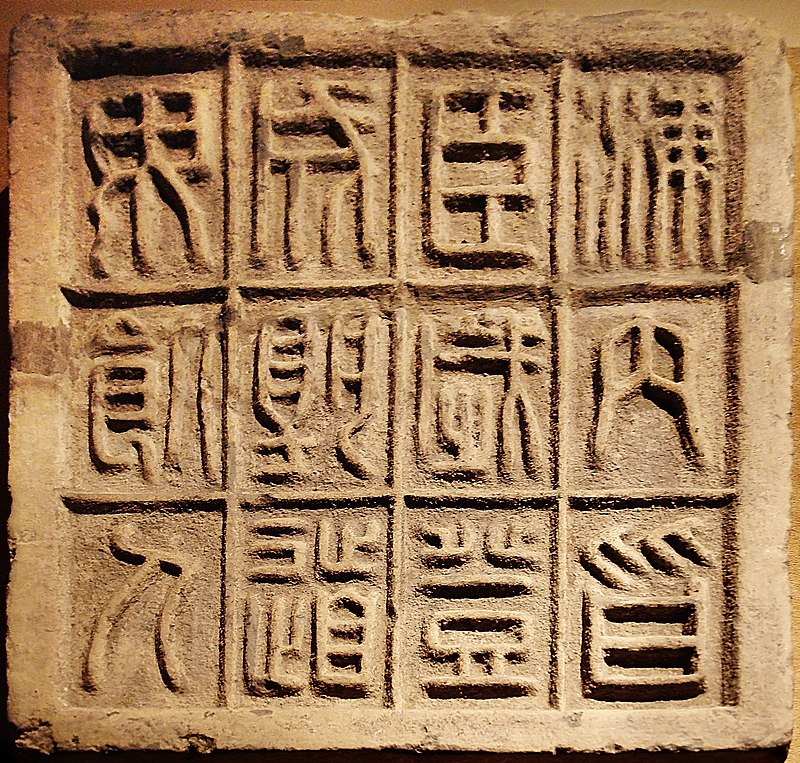
Stone slab with twelve small seal characters - Photo: wikipedia.org -
Around 220 BC, during the Qin and Warring States eras, the earliest Great Wall of China was constructed. Several nations constructed walls to secure their boundaries before to union. It was first constructed out of earth and straw. When emperor Qin unified the states in 221 BC, Qin Shi Huang once more commanded the devastation of these fortifications since they had split his dominion. However, in order to secure his northern border, Huang commissioned the building of a large defensive wall that connected the fortifications lining the empire's northern frontier. The wall was primarily constructed to defend against the Xiongnu tribes in the north and northwest, where the Qin Dynasty fought them. Although not much of this wall is visible now, it served as the sketch for the Great Wall of China.
A complex network of more than 4,000 miles of roads and a freeway, the Qinzhidao or "Straight Line," that extended around 500 miles along the Ziwu Mountains were among the engineering marvels of the Qin Empire. Additionally, it serves as a means of delivering building supplies for the Great Wall of China. Border walls that linked to form the head of the Great Wall served as the empire's northern border markers. 300,000 men were dispatched to construct the Great Wall under the direction of Qin road builder Meng Tian, who also oversaw the transportation of supplies on the public roads. This Qin Dynasty wall's construction is thought to have claimed the lives of hundreds of thousands of people.
Nowadays, modern builders have adapted building techniques akin to the Qin Dynasty's usage of cast earth in an effort to resurrect environmentally friendly structures throughout the world like using soil to construct China's Great Wall. This method is considered to be fast and cost-effective.
In short, one of the famous achievements of the Qin Dynasty is the construction of walls that served as the sketch for the Great Wall of China.
- In 221 BC, Qin Shi Huang ordered the destruction of previously built fortifications and instead built a large defensive wall connecting the fortifications to secure his northern border.
- The complex network was built of more than 4,000 miles of roads and highways, Qinzhidao or "Straight Lines" spanned about 500 miles with 300,000 workers working under Meng Tian's supervision.
- Hundreds of thousands of people died during this construction.
- Today, the construction method of the Great Wall is still used by modern builders.
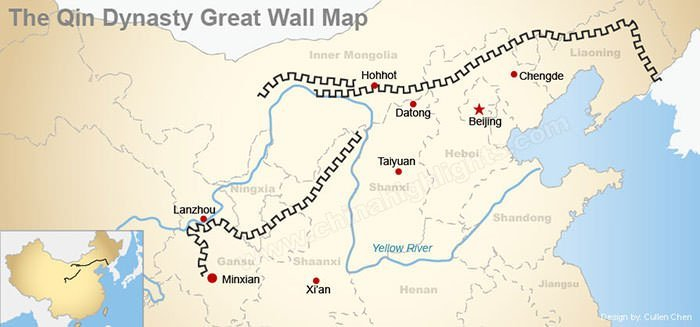
Map of the Great Wall of the Qin Dynasty - Photo: learnodo-newtonic.com History of The Great wall of China - Video: HTY-24h Active -
The Lingqu canal, which is sometimes referred to as the Dou Canal or the Xing'an Canal, is situated in Xing'an County in the Guangxi Zhuang Autonomous Region. It is a historic canal that unites the Xiang and Li rivers, and the Yangtze and Pearl river basins, and connects Central China with the Lingnan area. The 36.4 km long route passes through the cities of Xi'an, Yan'guan, Rongjiang, and Xiang'li. Its main projects include Canal Head Complex, the South Canal, and the North Canal.
Shi Lu was tasked by Emperor Qin Shi Huang with constructing a canal for the transportation of grain following the unification of China by the Qin Empire. The project, which is now known as the Lingqu Canal, was finished in 214 B.C. Until the building of the Yuehan Railway and Xianggui Railway in modern times, the Canal served as the main waterway for transportation between Lingnan (today's Guangdong and Guangxi) and Central China.
The main design principle of the Canal is to use weirs to raise the level of the Xiang River. Additionally, one stream is diverted through a new canal (today's North Canal), which meanders into the Xiang River, while another stream is directed through the South Canal into an upper branch of the Li River. The Yangtze and Pearl River river systems may communicate with one another thanks to the connection of the two rivers. Overflow dams, training dikes, and side overflow dams are used near the canal head to redirect water and manage to flood. Additionally, the Canal was developed by combining excavation and dam building, easing the slope's steepness with bends, controlling water flow with old locks and weirs, and using an existing natural waterway (the former Xiang River's route) or digging new canals to discharge floodwaters. This is a large-scale project that makes use of all the available natural resources and several hydraulic facilities. It displays the unique design and technical prowess of early Chinese hydraulic projects.
The Lingqu canal was also constructed as an irrigation project, transforming Xing'an into a developed agricultural area. After the People's Republic of China was established, the Canal had a comprehensive renovation and is now in excellent condition considering its age. Related canals and hydraulic infrastructure are still there despite the fact that it is no longer used for navigation and their irrigation role has been diminished. The Lingqu canal serves irrigation, flood control, water supply, and tourism nowadays in addition to being a significant piece of cultural history.
In the history of canals around the world, the Lingqu canal's technological system is extremely important. It is both proof of the exceptional canal technology of prehistoric China and a superb illustration of the first canals that exhibit Asian hydraulic and navigational expertise. Its design of a canal that spans a mountain range, a curving navigation path with locks, and precise control over water flow by extensive hydraulic systems are all creative and noteworthy accomplishments. It was built in 214 B.C. and played a crucial role in the Baiyue ethnic group's and the Lingnan region's conquest by the Qin Empire, as well as in maintaining peace in the southern area of a unified multicultural nation. The Lingqu canal's distinctive landform, winding waterways, and rural setting, on the other hand, are representative of old Chinese canal landscapes and have considerable artistic value.
In short, the construction of the Lingqu canal is considered a great Achievement of the Qin Dynasty:
- Lingqu canal is situated in Xing'an County in the Guangxi Zhuang Autonomous Region with a 36.4 km long route.
- It was designed by Qin Shi Lu and finished in 214 B.C.
- The main design principle of the Canal is to use weirs to raise the level of the Xiang River by combining excavation and dam building, easing the slope's steepness with bends, controlling water flow with old locks and weirs, and digging new canals to discharge floodwaters.
- It was also constructed as an irrigation project that transformed Xing'an into a developed agricultural area.
- The construction of this canal has brought great benefits to China to this day.
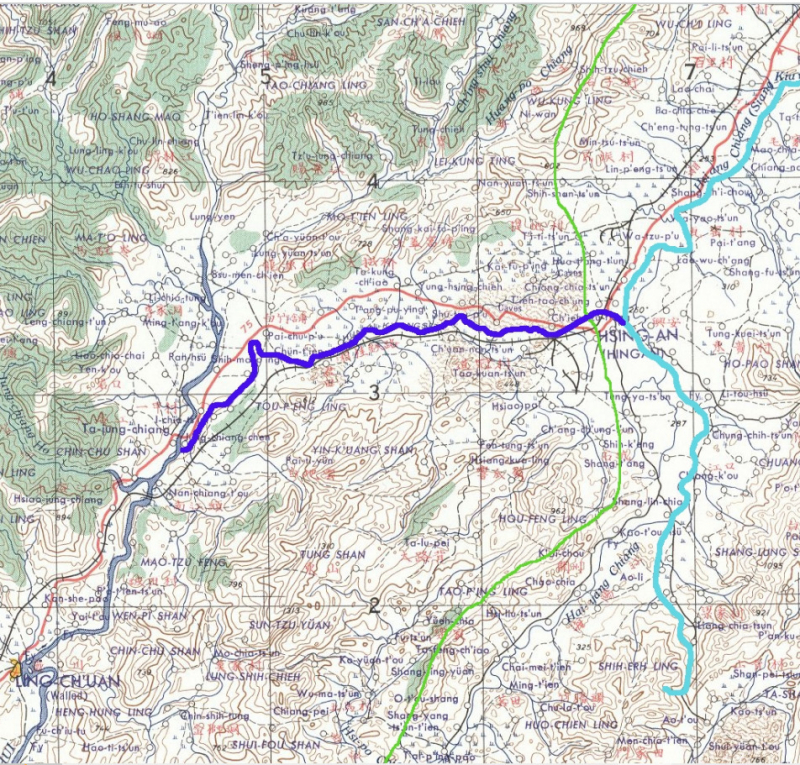
The route of the Lingqu (dark blue) - Photo: wikipedia.org Where the Lingqu canal connected China for Qin Shi Huang - Video: Geo Perspective -
The most cutting-edge weapons were used during the Qin Dynasty. Through several broad reforms, Qin Shi Huang significantly strengthened the military. The military at the time employed the most cutting-edge weapons. Initially, the army used weapons mainly in the form of bronze, but by the third century BC, the Qin army is considered to be the first army to replace it with iron and steel swords. Bellows were improved as a result of this metal's increased demand. The typical composite bow that was used previously was replaced in the fifth century BC by the crossbow, which was stronger and more precise.
During the excavation of the terracotta warriors, around 40,000 weapons, including war axes, crossbows, arrowheads, and spears, were discovered by researchers in the Terracotta Warriors were kept. A crossbow from 2,200 years ago was one of them. It could shoot an arrow 2,600 feet, double the range of a contemporary assault rifle. It was among the most powerful crossbows of its day and may have played a crucial role in significant Qin military triumphs.
To conclude, the Qin Dynasty invented cutting-edge weapons:
- By the third century BC, the Qin Army is considered to be the first army to replace bronze swords with iron and steel swords.
- The composite bow was replaced by the crossbow, which was stronger and more precise in the fifth century BC.
- Researchers discovered around 40,000 weapons, including war axes, crossbows, arrowheads, and spears in the excavation.
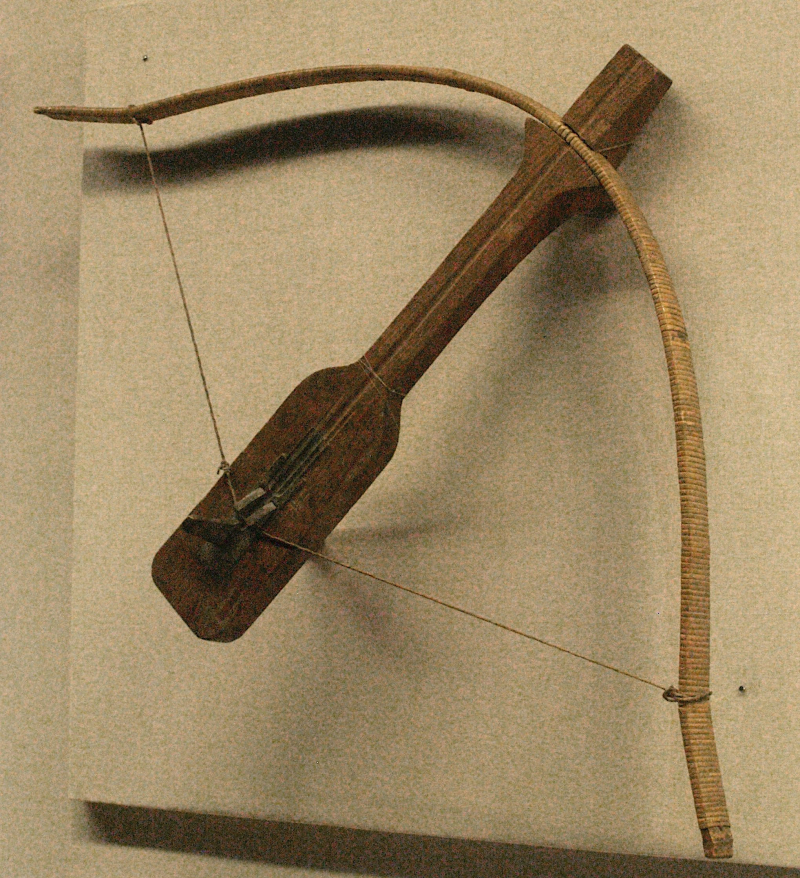
Crossbow in the Qin Dynasty - Photo: worldhistory.org 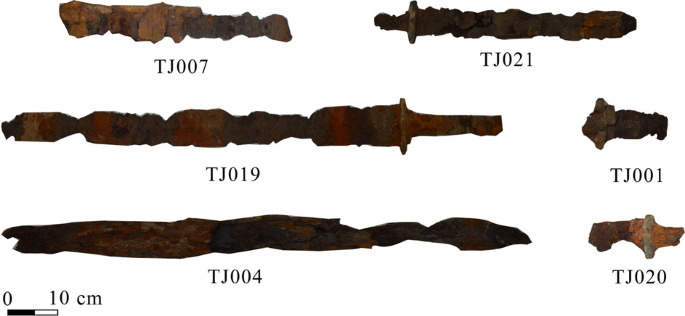
-
Residents who lived along the banks of the Min River experienced yearly floods during the Warring States era. Li Bing, a Qin hydrologist, found that the river was inflated by strong currents from nearby mountains that burst its banks when it got to the lower, slowly flowing, and densely alluvial part. A dam might have been erected as a solution, but the Qin preferred to maintain the waterway's accessibility for military vessels resupplying troops along the frontier. As a result, an artificial levee was constructed to redirect a portion of the river's flow, and then a canal was excavated through Mount Yulei to release any excess water into the distant, parched Chengdu Plain.
Tens of thousands of soldiers were dispatched by King Zhao of Qin to construct the system, along with 100,000 taels of money. The Zhulongs, which are long, sausage-shaped bamboo baskets loaded with stones and used to construct the dike, are secured in position by Machas, wooden tripods. And this construction of a dike that carried water like the mouth of a fish took four years to complete.
Dujiang Yuzui (fish mouth), Feishayan, and Baopingkou are the three primary components that make up the Dujiangyan Irrigation System's focal works. The Mingjiang River's water is diverted by the diversion dam Dujiang Yuzui into the Outer River and the Inner River. When the Inner River floods, Feishayan serves as a spillway to transfer extra water and sand to the Outer River. An irrigation system inlet called Baopingkou has automated flow control. These three components work together as an organic whole to perform a wide range of tasks, including water diversion, flood discharge, sediment discharge, sedimentation, and autonomous irrigation water control.
The initiative not only mitigates floods but also elevates Sichuan to China's most prosperous agricultural area. Built-in 256 BC, it is still in use today to irrigate more than 5,300 square kilometers of land. The Dujiangyan Irrigation System is considered an important building in the development of Chinese science and is still in use today. It is also the oldest surviving dam-free irrigation system in the world and is a UNESCO World Heritage Site.
To conclude, the Qin Dynasty constructed the Dujiangyan irrigation system:
- Tens of thousands of soldiers were dispatched by King Zhao of Qin to construct the system, along with 100,000 taels of money, and took four years to complete.
- The Dujiangyan Irrigation System involved three components: the Dujiang Yuzui (fish mouth), Feishayan, and Baopingkou.
- It was considered an important building in the development of Chinese science, also the oldest surviving dam-free irrigation system in the world, and is a UNESCO World Heritage Site.
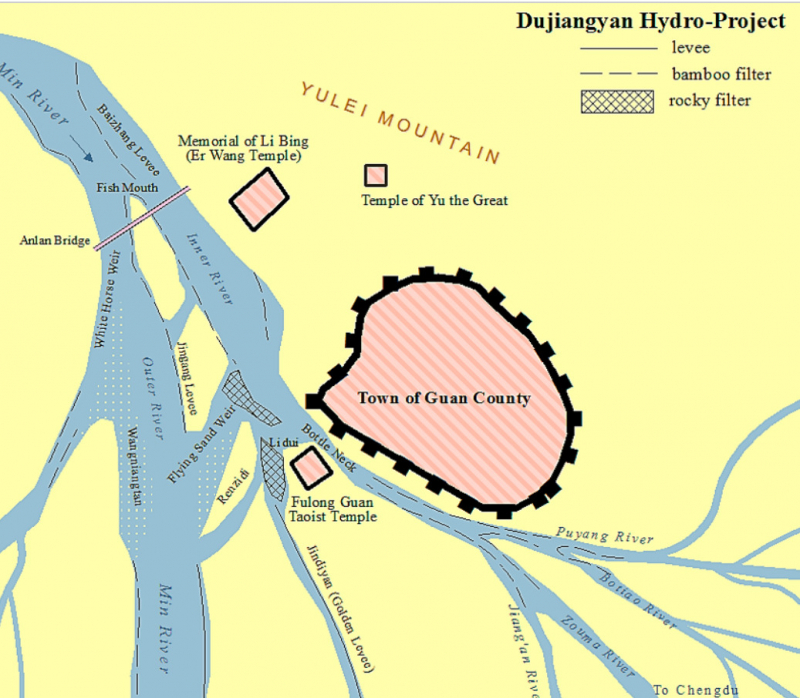
The map showing the plan of Dujiangyan project - Photo: wikipedia.org 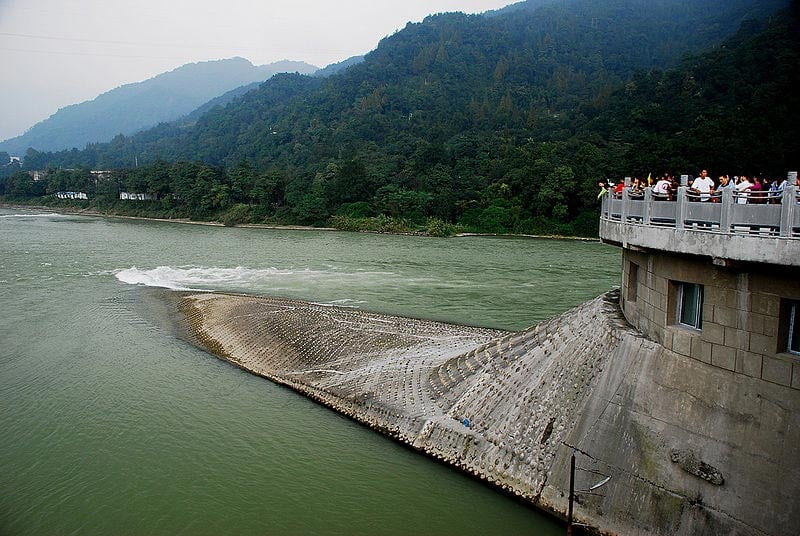
Photo: worldmap.com -
Near the Chinese province of Shaanxi, Lintong County, in the city of Xi'an, is home to the Mausoleum of Emperor Qin Shi Huang. This tomb, which is situated underneath a 76-meter-high mound fashioned like a truncated pyramid, was constructed over the course of 38 years between 246 and 208 BC.
Construction of the mausoleum began shortly after Emperor Qin rose to the throne in 246 BC. However, it was not until he had defeated six other significant nations and Unified China in 221 BC that full-scale building started. According to the geographer Li Daoyuan, Mount Li was chosen as the location for his burial because of its favorable geology, which has a northern slope rich in gold and jade reserves. The first emperor decided to be buried there because he desired its good reputation.
The well-known Terracotta Army of life-sized Terracotta Warriors, which is used to guard the Emperor against bad spirits in the afterlife, is housed in the tomb. The distinct facial characteristics of each terracotta soldier in the army suggest a high degree of craftsmanship and skill. The generals are the tallest of the figures, whose heights vary depending on their functions. The Terracotta Army reportedly had more than 8,000 troops, 130 chariots with 520 horses, and 150 cavalry horses, according to a 2007 estimate.
The tomb has not been extensively excavated in recent years, although the surrounding region has been investigated using a variety of methods. A brick wall used as the wall of the temple was discovered through archaeological investigation and the examination of magnetic anomalies. It was 4 meters high, 460 meters long from north to south, and 390 meters from east to west. A pit with bronze chariots and horses was also discovered, and it is connected to the mausoleum's western route. In 1987, the complex was designated a UNESCO World Heritage site. Archaeologists estimated that it would take years to uncover the full tomb complex as they continued their excavations on the site into the twenty-first century.
In sum, the Mausoleum of Emperor Qin Shi Huang:
- near Shaanxi, Lintong County, in the city of Xian.
- was constructed over the course of 38 years and began shortly after Emperor Qin rose to the throne in 246 BC.
- had more than 8,000 troops, 130 chariots with 520 horses, and 150 cavalry horses.
- In 1987, the complex was designated a UNESCO World Heritage site.
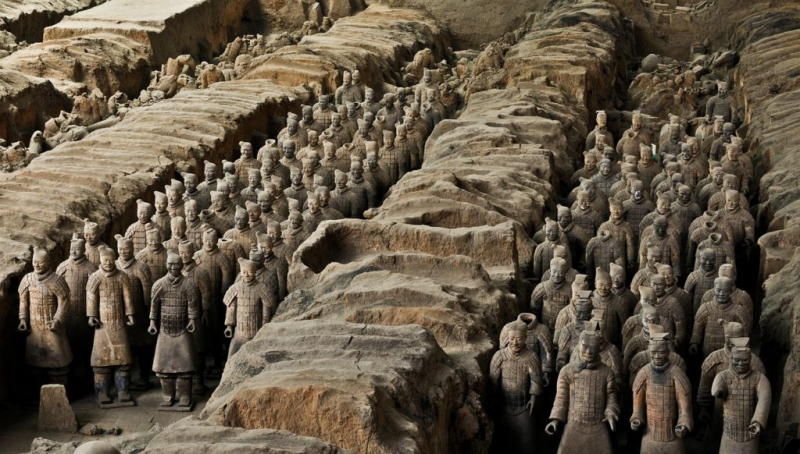
The Terracotta Army - Photo: howitworksdaily.com










